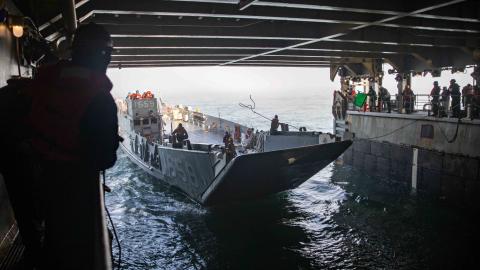Last week was a big one for NATO. After months of delays, Türkiye’s parliament finally voted on Tuesday to ratify Sweden’s entry into the alliance, so NATO is now on the verge of adding its 32nd member.
The following day, more than 8,000 kilometers away from the Turkish parliament in Ankara, the USS Gunston Hall, a large US Navy amphibious assault ship, left its port in Norfolk, Virginia, en route to Europe. While such a deployment might seem routine for the US Navy, the departure of the Gunston Hall fired the starting gun for Steadfast Defender 2024, NATO’s largest military exercise since the Cold War.
The goal of the exercise is to test how well NATO could respond if one of its members were attacked and the alliance’s Article 5 mutual defense clause were invoked. It will begin in earnest in February and continue until May, with more than 90,000 troops and thousands of pieces of military equipment taking part. Every NATO member will participate, but most of the action over the coming months will take place in northern and eastern Europe.
This is the largest NATO exercise in Europe since 1988, when more than 125,000 alliance troops trained together across the continent during the final uncertain days of the Cold War. The next-largest exercise in recent years was in 2018, but even that had only about half the number of troops that will take part this year.
In the past, the focus of NATO exercises has been almost exclusively on eastern Europe. In 2018, the focus moved to southern Europe and the Mediterranean. It is therefore noteworthy that this year’s focus is on northern Europe. In fact, the first stop of the Gunston Hall after departing the US east coast is Norway,where it will pick up Norwegian, Swedish, and Finnish forces for training. This all makes sense for the alliance. With Finland now a NATO member and Sweden about to join, seven of the eight Arctic countries are now under the same security umbrella.
Moreover, the timing of this exercise is no coincidence. The 75th anniversary of NATO’s founding is this year, and will be marked with a large NATO summit in Washington in July. Before this summit, such a large NATO military exercise will be a useful reminder to policymakers and the public of the alliance’s usefulness and relevance, today and into the future. This year is also the 20th anniversary of Bulgaria, Estonia, Latvia, Lithuania, Romania, Slovakia, and Slovenia —mostly former Soviet Union and Warsaw Pact countries — joining NATO. These are the alliance members who feel most under threat from outside aggression, which is why this year’s NATO exercise is both timely and important.
Of course, 2024 also is a presidential election year in the US. Among some on America’s political right, led by Donald Trump, there have been questions about the value of US membership of NATO. On the other side of the political aisle, Democrats have done little to bring new ideas or initiatives to the alliance to prepare it for the 21st century. We can only hope that such a large military training exercise will remind US politicians of the importance of NATO to the national interest.
Support for NATO should be a no-brainer for American policymakers. Europe is America’s largest economic export market: 45 of the 50 American states export more to Europe than they do to China, supporting millions of American jobs. Europe is also the largest source of foreign investment into the US, and it is the NATO alliance that guarantees the continent’s stability. As the political debate heats up in the US, it would be wise for Americans to recognize the importance of NATO.
There is no doubt that the war in Ukraine has been the main motivation for NATO to hold such a large-scale training exercise. However unlikely it may seem to those outside the region, many countries in eastern Europe are genuinely concerned that they could be next on Russia’s list for military aggression.
The thousands of NATO troops participating in Steadfast Defender 2024 are not training to attack or invade a neighboring country. They are rehearsing how to come to the defense of a country that may be a victim of outside aggression that triggers NATO’s collective security guarantee.
Large-scale NATO better prepare the alliance for its mission of collective defense, reassure vulnerable member states of NATO’s commitment to collective security, and ultimately serve as a deterrent against any outside aggressor.
With the war in Ukraine showing no sign of ending, and with Russia re-arming and shifting its defense industry to more of a war footing, it would be irresponsible if NATO did not hold major military exercises.
As long as no country plans to attack a member of NATO, the Steadfast Defender 2024 exercise should not be viewed as a threat.















